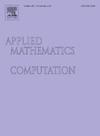Corrigendum to “Mathematical modeling of electro hydrodynamic non-Newtonian fluid flow through tapered arterial stenosis with periodic body acceleration and applied magnetic field” [Applied Mathematics and Computation, 362(2019) 124453]]
IF 3.5
2区 数学
Q1 MATHEMATICS, APPLIED
引用次数: 0
Abstract
A mathematical model is proposed to the pulsatile flow of blood in a tapered artery with mild constriction. This study considers blood as an electrically conducting, non-Newtonian fluid (Jeffrey fluid) which contains magnetic nanoparticles. As blood conducts electricity, it exerts an electric force along the flow direction due to the induced magnetic force by an applied magnetic field which produces Lorentz force and influences the fluidity. Assuming that the pulsatile fluid flow is accelerated by a body force that has in slip velocity at the wall, a set of coupled nonlinear Navier–Stokes equation governing the flow networks is obtained. By employing Laplace and Hankel transforms on the partial equations, we obtain an exact solution for the velocity of flow pattern. Further, the evaluated axial velocity of both fluid and particle are used to find the physiological quantities such as shear stress, flow resistivity and volume of fluid flow. Their dependency on the Womersley parameter, Hartmann number, shape parameter, Jeffrey number and electrokinetic number are calculated numerically and explained graphically. Furthermore, the results are compared within slip and no slip velocities.
求助全文
约1分钟内获得全文
求助全文
来源期刊
CiteScore
7.90
自引率
10.00%
发文量
755
审稿时长
36 days
期刊介绍:
Applied Mathematics and Computation addresses work at the interface between applied mathematics, numerical computation, and applications of systems – oriented ideas to the physical, biological, social, and behavioral sciences, and emphasizes papers of a computational nature focusing on new algorithms, their analysis and numerical results.
In addition to presenting research papers, Applied Mathematics and Computation publishes review articles and single–topics issues.

 求助内容:
求助内容: 应助结果提醒方式:
应助结果提醒方式:


